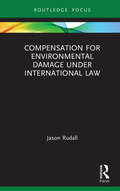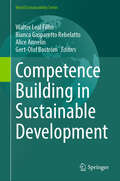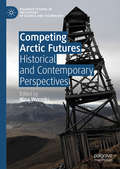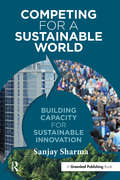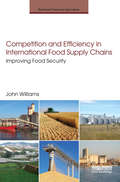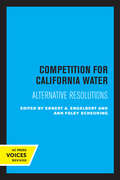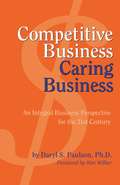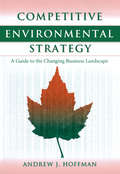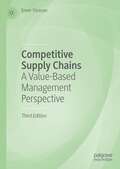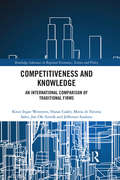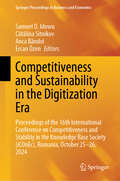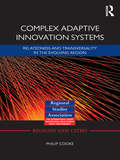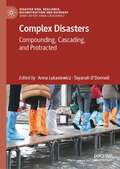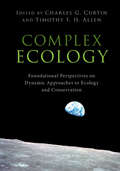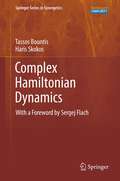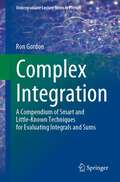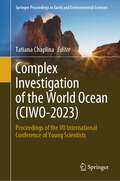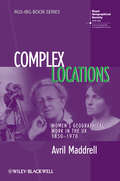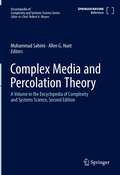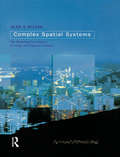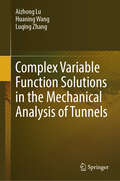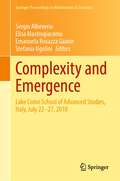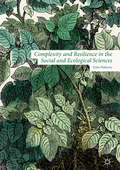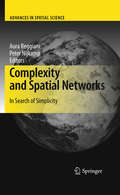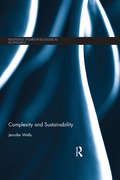- Table View
- List View
Compensation for Environmental Damage Under International Law (Routledge Research in International Environmental Law)
by Jason RudallInspired by recent litigation, this book identifies and critically appraises the manifold and varied approaches to calculating compensation for damage caused to the environment. It examines a wide range of practice on compensation – in general and specifically for environmental damage – from that of international courts and tribunals, as well as international commissions and regimes, to municipal approaches and other disciplines such as economics and philosophy. Compensation for Environmental Damage Under International Law synthesises these approaches with a view to identifying their blind spots, bringing clarity to an area where there exists broad discrepancy, and charting best practices that appropriately balance the manifold interests at stake. In particular, it is argued that best practice methodologies should ensure compensation serves to fully repair the environment, reflect the emerging ecosystems approach and any implications environmental damage may have for climate change, as well as take into account relevant equitable considerations. This book is essential reading for academics, practitioners and students working in the field of environmental law.
Competence Building in Sustainable Development (World Sustainability Series)
by Walter Leal Filho Bianca Gasparetto Rebelatto Alice Annelin Gert-Olof BoströmThis book aims to provide a comprehensive guide to understanding and implementing the competencies required for sustainable development. In recent years, the need for sustainable development has become increasingly evident across various sectors globally. Climate change, resource depletion, and social inequalities pose significant challenges that demand urgent and comprehensive action. The concept of sustainable development is not merely an environmental concern; it encompasses economic, social, and governance dimensions, necessitating a holistic approach to address these interlinked issues effectively. It seeks to bridge the gap between theoretical frameworks and practical applications, offering insights that are relevant to policymakers, educators, business leaders, and individuals committed to sustainability. The genesis of this book lies in the recognition that achieving sustainable development is contingent upon building and enhancing competencies at multiple levels—individual, organizational, and societal. Competence in sustainable development involves a combination of knowledge, skills, attitudes, and values that empower individuals and organizations to contribute effectively to sustainable goals. One of the key strengths of this book is its multidisciplinary approach. Sustainable development is inherently interdisciplinary, requiring insights from environmental science, economics, social sciences, and management studies. The contributors to this book bring diverse perspectives and expertise, ensuring a rich and nuanced exploration of the subject matter. Furthermore, this book emphasizes the importance of education and training in building competencies for sustainable development. It discusses innovative educational approaches, curricula development, and the role of institutions in fostering a culture of sustainability. The role of technology and digital tools in enhancing sustainable practices is also highlighted, recognizing their potential to drive significant positive change.
Competing Arctic Futures: Historical and Contemporary Perspectives (Palgrave Studies in the History of Science and Technology)
by Nina WormbsThis edited collection explores how narratives about the future of the Arctic have been produced historically up until the present day. The contemporary deterministic and monolithic narrative is shown to be only one of several possible ways forward. This book problematizes the dominant prediction that there will be increased shipping and resource extraction as the ice melts and shows how this seemingly inevitable future has consequences for the action that can be taken in the present. This collection looks to historical projections about the future of the Arctic, evaluating why some voices have been heard and championed, while others remain marginalised. It questions how these historical perspectives have shaped resource allocation and governance structures to understand the forces behind change in the Arctic region. Considering the history of individuals and institutions, their political and economic networks and their perceived power, the essays in this collection offer new perspectives on how the future of the Arctic has been produced and communicated.
Competing for a Sustainable World: Building Capacity for Sustainable Innovation
by Sanjay SharmaSustainable innovation requires more than a clear vision and commitment. It requires effective execution and implementation based on an ongoing systematic process of engaging stakeholders to generate the evolving information critical for guiding decision-making, developing and implementing business logic for sustainable innovation, overcoming decision-making biases by managers, creating an opportunity framework to spark creativity, and developing effective organizational capabilities to build a sustainable innovation DNA within the organization. Such a capacity provides an organization with the ability to anticipate and overcome internal and external barriers and achieve competitive advantage through sustainable innovation of products, services, and business models. Based on original research, current state-of-the-knowledge, and relevant examples, this book comprehensively outlines and describes the process that managers can undertake to effectively and successfully implement a sustainability strategy that will help them attract and retain managerial talent; increase operating legitimacy and reduce compliance costs; boost stakeholder support; reduce costs through increased efficiency, quality, reliability, safety, and responsiveness of existing operations; foster radical innovations in processes, products, services, and new markets; and promote competitive imagination of future products, services, and business models.
Competition and Efficiency in International Food Supply Chains: Improving Food Security (Earthscan Food and Agriculture)
by John WilliamsWhy have food crises seemingly become more frequent in recent years, compared to the last few decades? This book examines an array of different issues and distortions that are causing food supply chain dysfunction in many countries, particularly for staple non-perishable foods such as grains, oilseeds, pulses and sugar. It outlines the underlying changes that are currently occurring, which will have an influence on the direction of future food supply chains, and provides some solutions to current food security problems. Based on an analysis of total regulation in the 1950s-60s through to deregulation during the 1980-90s, as well as post-deregulation, it focuses on liberal trade and deregulation as a more successful solution to creating efficiencies in food supply chains and distribution. The author highlights a common thread of either farmers using government for vested-interest intervention, or autocratic governments seeking market and supply-chain power. The book examines the role of government after 70 years of food supply chain intervention. It discusses the role of commercial ‘trade’ markets and cluster industries and how these can quickly disintegrate when price distortions occur. The author studies both food importing and exporting countries and concludes that comingled commoditization of food has led to increased hoarding, corruption, and dependence on food aid. He argues that a competitive food supply chain that has minimum intervention is more likely to provide future food security. In conclusion the book emphasizes that adequate rewards, competition, and striving for supply chain efficiencies are the essences of sustainable food security.
Competition for California Water: Alternative Resolutions
by Ernest A. Engelbert Ann Foley ScheuringCalifornia’s water is at the center of an intense economic and political struggle. A balance between supply and demand must be reached, but it is far from certain that all Californians will get as much water as they want at a price they feel is right. Competition for California Water presents essential information on key issues, including: Costs: What would be the yields and what would be the costs, in dollars as well as less tangible values, of developing new sources of water? Cost-sharing: How much of the cost of water development and distribution should be borne by the general public, and how much by water users and other beneficiaries? Environmental protection: To what extent should environmental values be protected? Conservation: To what extent can the need for new water development be offset by conservation and more efficient use of water? Institutional reform: Can changes in the laws and institutions of California produce a more efficient system of water supply and management? Agriculture: How much increase in cost and/or loss of water can California agriculture bear and still remain competitive? Thirty-one experts on all aspects of this topic project alternative futures for California’s water supply. Written in nontechnical language, Competition for California Water is an invaluable source of information for Californians concerned with the future of their state.This title is part of UC Press's Voices Revived program, which commemorates University of California Press’s mission to seek out and cultivate the brightest minds and give them voice, reach, and impact. Drawing on a backlist dating to 1893, Voices Revived makes high-quality, peer-reviewed scholarship accessible once again using print-on-demand technology. This title was originally published in 1982.
Competitive Business, Caring Business: An Integral Business Perspective for the 21st Century
by Daryl PaulsonCompetitive Business, Caring Business is designed to provide managers and executives with new tools and methods for finding personal satisfaction in their unique contributions to the teams, companies, or industries they serve. The author, Daryl Paulson, the CEO of BioScience Laboratories, Inc., has successfully combined science and business in his personal and professional life and demonstrated in clear, simple, practical terms the true meaning of "integral business." In Competitive Business, Caring Business, he shows how the work of Ken Wilber, the world's foremost human science theorist, applies in the business domain. Paulson explains why the process of "doing business" must be considered in a holistic and integral manner if it is to meet the needs of the 21st century. Readers will learn how a win-win strategy can be developed which satisfies individual employees, work teams, senior management, and shareholders, as well as society and larger global concerns. Unlike other approaches, Paulson's integrative process of doing business is at once profitable, personally satisfying, and beneficial to the environment.
Competitive Environmental Strategy: A Guide To The Changing Business Landscape
by Andrew J. HoffmanEnvironmental concerns can greatly affect business success, regardless of whether a business person or corporation shares those concerns. Today's corporate managers must understand the power of environmental issues, and shift their mindset from one focused on environmental "management" to one focused on strategy.Competitive Environmental Strategy examines the effects of environmentalism on corporate management, explaining how and why environmental forces are driving change and how business managers can think about environmental issues in a strategic way. The author discusses: the evolving drivers of corporate environmental strategy, including regulators, shareholders, buyers and suppliers, insurers, investors, and consumers how environmentalism alters basic conceptions of competitive strategy and organizational design how external institutions create both opportunity and limitations for environmental strategy how environmental threats can be incorporated into risk management, capital acquisition, competitive position, and other management concerns The book ends with an overall discussion of competitive environmental strategy and draws connections to the emerging issue of sustainable development. Each chapter features insets that ask fundamental questions about the relationship between environmental protection and business strategy, and ends with a list of additional recommended readings. Every individual who wishes to engage in business management in the 21st century will need an appreciation for the implications of environmental issues on corporate activities, and vice-versa.Competitive Environmental Strategy offers a valuable overview of the subject, and provides a wealth of real-world examples that demonstrate the validity and applicability of the concepts for business people, clearly showing how managers are turning an understanding of environmental issues to competitive advantage.
Competitive Supply Chains: A Value-Based Management Perspective
by Enver YücesanThis timely and highly relevant book refocuses the discussion on supply chain innovation for an era of unprecedented challenges and opportunities in global supply chain operations. This third edition builds upon the ideas explored by the author in Competitive Supply Chains (2007, 2016), featuring new content and analysis, new case studies and a complete reassessment on the impact of new technologies, ESG requirements, and geopolitical challenges.Featuring case studies from European and Asian companies, this book is an essential resource for researchers and students of supply chain and operations management.
Competitiveness and Knowledge: An International Comparison of Traditional Firms (Routledge Advances in Regional Economics, Science and Policy)
by Knut Ingar Westeren Hanas Cader Maria de Sales Jan Ole Similä Jefferson StadutoIn the twenty-first century technology has become global, and firms compete using knowledge and capital. The ‘traditional firm’ has a need for innovation and depends on efficient knowledge management to improve productivity. This book examines five firms that produce the same commodity, white chicken meat, in different parts of the world and under very different conditions. It brings to bear the expertise and international perspectives of the author team, utilizing theoretical discussions and case studies to address the question: How do local firms use knowledge to compete in an increasingly globalized world? This book will be of interest to any postgraduate student, researcher or policymaker hoping to achieve a firmer grasp of innovation and knowledge management: a recurring and highly pertinent theme in contemporary economics.
Competitiveness and Sustainability in the Digitization Era: Proceedings of the 16th International Conference on Competitiveness and Stability in the Knowledge Base Society (iCOnEc), Romania, October 25—26, 2024 (Springer Proceedings in Business and Economics)
by Samuel O. Idowu Ercan Özen Cătălina Sitnikov Anca BăndoiThis book analyzes digital transformation in organizations through digital strategy, digital capability, and digital culture. Featuring contributions presented at the 16th International Conference on Competitiveness and Stability in the Knowledge Base Society (iCOnEc), the book explores the influence of digital transformation which has on companies&’ sustainability and competitiveness, particularly in times of economic uncertainty.Megatrends like digitalization are reshaping society and the economy. In an ever-evolving world, businesses play a crucial role in enabling society to carry out digital transformation and engage in competitive and sustainable growth to improve performance as well as socioeconomic and environmental sustainability. The enclosed chapters examine the relationship and mechanisms connecting digital transformation to ongoing business growth.Presenting both conceptual and operational perspectives on emerging issues, this book is useful for researchers, scholars, students, and policymakers in digital transformation and organizational sustainability and competitiveness.
Complex Adaptive Innovation Systems: Relatedness and Transversality in the Evolving Region (Regions And Cities Ser. #55)
by Philip CookeLeading up to the financial crisis of 2008 and onwards, the shortcomings of traditional models of regional economic and environmental development had become increasingly evident. Rooted in the idea that ‘policy’ is an encumbrance to free markets, the stress on supply-side smoothing measures such as clusters and an over reliance on venture capital, the inadequacy of existing orthodoxies has come to be replaced by the notion of Transversality. This approach has three strong characteristics that differentiate it from its failing predecessor. First, as the name implies, it seeks to finesse horizontal knowledge interactions as well as vertical ones, thus building ‘platforms’ of industrial interaction. Secondly, it is not a supply, but a demand side model in which needs-driven innovation rather than pure market competition prevails. Finally, it is ongoing through recessionary times, being more robust than over-specialised approaches to economic growth. The intellectual origins of Transversality lie in an aspiration to promote eco-innovation, one of the key hopes of assisting Western regional and national economies to re-balance and escape recession. The policy models of key regional exponents of the concept are explored and their goals achievement is assessed. An array of policy instruments and measures is presented for hands-on policy implementation. The book will be of vital interest to academics as teachers and researchers as well as policy advisers and public servants.
Complex Disasters: Compounding, Cascading, and Protracted (Disaster Risk, Resilience, Reconstruction and Recovery)
by Tayanah O’Donnell Anna LukasiewiczThis Edited book introduces the concept of complex disasters and considers both disaster risks and impacts across the disaster management spectrum – Prevention – Preparation – Response and Recovery. Three types of complex disasters are analysed – ‘Compound’, ‘Cascading’ and ‘Protracted’. Case studies include hazards from fires, through to floods, sea level rise and typhoons are explored through case studies from Australia and the Asia Pacific region. Each is written by scholars and/or practitioners with acknowledged expertise in the field and most chapters are based on detailed case studies of ongoing or recent research projects. The book will be useful to researchers in climate, disaster, or environmental and economic policy, disaster risk reduction, and climate change studies, and practitioners and policy makers applying disaster theory and knowledge into policy and decision-making.
Complex Ecology: Foundational Perspectives Of A Dynamic View Of Ecology And Conservation
by Timothy F. Allen Charles G. CurtinFrom climate change to species extinction, humanity is confronted with an increasing array of societal and environmental challenges that defy simple quantifiable solutions. Complexity-based ecology provides a new paradigm for ecologists and conservationists keen to embrace the uncertainty that is pressed upon us. This book presents key research papers chosen by some sixty scholars from various continents, across a diverse span of sub-disciplines. The papers are set alongside first person commentary from many of the seminal voices involved, offering unprecedented access to experts' viewpoints. The works assembled also shed light on the process of science in general, showing how the shifting of wider perspectives allows for new ideas to take hold. Ideal for undergraduate and advanced students of ecology and conservation, their educators and those working across allied fields, this is the first book of its kind to focus on complexity-based approaches and provides a benchmark for future collected volumes.
Complex Hamiltonian Dynamics (Springer Series in Synergetics #10)
by Haris Skokos Tassos BountisThis book introduces and explores modern developments in the well established field of Hamiltonian dynamical systems. It focuses on high degree-of-freedom systems and the transitional regimes between regular and chaotic motion. The role of nonlinear normal modes is highlighted and the importance of low-dimensional tori in the resolution of the famous FPU paradox is emphasized. Novel powerful numerical methods are used to study localization phenomena and distinguish order from strongly and weakly chaotic regimes. The emerging hierarchy of complex structures in such regimes gives rise to particularly long-lived patterns and phenomena called quasi-stationary states, which are explored in particular in the concrete setting of one-dimensional Hamiltonian lattices and physical applications in condensed matter systems. The self-contained and pedagogical approach is blended with a unique balance between mathematical rigor, physics insights and concrete applications. End of chapter exercises and (more demanding) research oriented problems provide many opportunities to deepen the reader's insights into specific aspects of the subject matter. Addressing a broad audience of graduate students, theoretical physicists and applied mathematicians, this text combines the benefits of a reference work with those of a self-study guide for newcomers to the field.
Complex Integration: A Compendium of Smart and Little-Known Techniques for Evaluating Integrals and Sums (Undergraduate Lecture Notes in Physics)
by Ron GordonIntegrals and sums are not generally considered for evaluation using complex integration. This book proposes techniques that mainly use complex integration and are quite different from those in the existing texts. Such techniques, ostensibly taught in Complex Analysis courses to undergraduate students who have had two semesters of calculus, are usually limited to a very small set of problems. Few practitioners consider complex integration as a tool for computing difficult integrals. While there are a number of books on the market that provide tutorials on this subject, the existing texts in this field focus on real methods. Accordingly, this book offers an eye-opening experience for computation enthusiasts used to relying on clever substitutions and transformations to evaluate integrals and sums. The book is the result of nine years of providing solutions to difficult calculus problems on forums such as Math Stack Exchange or the author's website, residuetheorem.com. It serves to detail to the enthusiastic mathematics undergraduate, or the physics or engineering graduate student, the art and science of evaluating difficult integrals, sums, and products.
Complex Investigation of the World Ocean: Proceedings of the VII International Conference of Young Scientists (Springer Proceedings in Earth and Environmental Sciences)
by Tatiana ChaplinaThe book presents the most relevant research of the participants of the VII International Conference of Young Scientists "Complex Investigation of the World Ocean" (CIWO-2023). This conference was held at Saint Petersburg State University in May 15-19, 2023 (Saint Petersburg, Russia). It covers a wide range of fundamental and applied marine and limnology studies combined in eight sections: Ocean Physics, Ocean Biology, Ocean Chemistry, Marine Geology, Marine Geophysics, Marine Ecology and Environmental Management, Physical and Biological interactions (interdisciplinary section), Oceanological Technology and Instrumentation. The aim of this book is to show the relevance of the marine research due to the crucial role of the World Ocean in determining climate change on Earth, huge resources (fish resources, oil, gas and ore deposits, etc.) and intensive development of infrastructure in coastal and offshore zones. All these topics were marked within the framework of realization of the United Nations Decade of Ocean Science for Sustainable Development (2021-2030). The studies presented in the book covers the wide spectrum of different the most important marine and limnology issues: thermohaline structure of water body and interactions between ocean and atmosphere, dynamic of the ocean, marine ice in polar regions, biodiversity of the marine ecosystems, adaptation of marine life to climate changes, geological and geophysical investigations in oil and gas regions, sedimentation, paleooceanology and biostratigraphy, hydrochemistry of estuary regions and carbon fluxes, microplastic pollution of the ocean, eutrophication and etc.
Complex Locations: Women's Geographical Work in the UK 1850-1970 (RGS-IBG Book Series #61)
by Avril MaddrellThis enlightening book makes visible the lives and works of women who played a critical role in the development of geography as an academic field. A rare and detailed analysis of the geographical work of 30 individual women geographers from 1850 to 1970 Includes oral histories from women who have held appointments in British universities since World War II Makes the work of women geographers visible and challenges the notion of pre 1970s geography as an overwhelmingly masculine field Makes an important contribution to debates about the theoretical and methodological framing of the historiography of geography
Complex Media and Percolation Theory (Encyclopedia of Complexity and Systems Science Series)
by Muhammad Sahimi Allen G. HuntPercolation theory describes the effects of the connectivity of microscopic or small-scale elements of a complex medium to its macroscopic or large-scale properties. It also describes the conditions under which there may be a continuously connected path of local elements across the medium. The point at which the path is formed is called the percolation threshold. Percolation theory also predicts that many macroscopic properties of complex media follow universal power laws near the percolation threshold that are independent of many microscopic features of such media.There are many applications of percolation theory across the natural sciences, from porous materials, to composite solids, complex networks, and biological systems. This book presents the essential elements of percolation theory, covers the problem of calculating the exponents that characterize the power laws that the percolation quantities follow near the percolation threshold, provides a clear description of the geometry of percolation clusters of the connected paths, and addresses several variations of percolation theory. In particular, bootstrap percolation, explosive percolation, and invasion percolation are featured, which expand the range of natural systems to which percolation may be applicable. In addition, coverage includes several important applications of percolation theory to a range of phenomena, ranging from electrical conductivity, thermopower, the Hall effect, and photoconductivity of disordered semiconductors, to flow, transport and reaction in porous media, geochemistry, biology, and ecology.
Complex Spatial Systems: The Modelling Foundations of Urban and Regional Analysis
by Alan Geoffrey WilsonA comprehensive core text from the expert in the field introducing students to the main issues of spatial systems modelling and analysis.
Complex Variable Function Solutions in the Mechanical Analysis of Tunnels
by Aizhong Lu Huaning Wang Luqing ZhangThis book covers the mechanical problems of tunnels in traffic, hydraulic and mining engineering. By extending the complex variable method in mechanical analysis, it proposes accurate analytical solutions for tunnels. The solutions are further applied to the back analysis of tunnels, hole shape optimization, support design and estimation of tunnel stability. The considered rock characteristics involve elasticity, elastoplasticity, viscoelasticity and anisotropy, and various geometric conditions are included, such as circular/noncircular single/multiple tunnels with/without support at deep/shallow depths. Some original achievements are provided, including new mapping functions for complex regions, precise determination of the noncircular plastic zone around single/twin tunnels and related elastoplastic solutions and quantitative analysis of the interaction between rock and the support, which are new developments of theory and method in rock mechanics. The proposed analyticalsolutions are reliable tools to initially estimate the design parameters and achieve optimal design, providing guidance in the conceptual stage of the design process. They can clearly reveal the influences of parameters in functional form and provide a benchmark against which the overall correctness of numerical analyses can be assessed. This book summarizes the author's research achievements over more than 20 years. It is a valuable reference for professionals working in geotechnical engineering.
Complexity and Emergence: Lake Como School of Advanced Studies, Italy, July 22–27, 2018 (Springer Proceedings in Mathematics & Statistics #383)
by Sergio Albeverio Emanuela Rosazza Gianin Stefania Ugolini Elisa MastrogiacomoThis book includes contributions about mathematics, physics, philosophy of science, economics and finance and resulted from the Summer School “Complexity and Emergence: Ideas, Methods, with a Special Attention to Economics and Finance” held in Lake Como School of Advanced Studies, on 22–27 July 2018.The aim of the book is to provide useful instruments from the theory of complex systems, both on the theoretical level and the methodological ones, profiting from knowledge and insights from leading experts of different communities. It moves from the volume editors' conviction that to achieve progress in understanding socio-economical as well as ecological problems of our complex word such preparation is needed, together with a critical reconsideration of our basic scientific and economical approach.The potential readers are primarily master and doctorate students of mathematics, information sciences, theoretical physics and economics, as well as research workers in those areas, who want to enlarge their spectrum of knowledge towards the area of complexity and emergence. Since ideas and methods of the theory of complex systems also apply to other areas (from engineering and architecture to biology and medicine, e.g.), students and research workers from those areas will also profit from this book.
Complexity and Resilience in the Social and Ecological Sciences
by Eoin FlahertyThis book introduces a new approach to environmental sociology, by integrating complexity-informed social science, Marxian ecological theory, and resilience-based human ecology. It argues that sociologists have largely ignored developments in ecology which move beyond functionalist approaches to systems analysis, and as a result, environmental sociology has failed to capitalise not only on the analytical promise of resilience ecology, but on complementary developments in complexity theory. By tracing the origins and discussing current developments in each of these areas, it offers several paths to interdisciplinary dialogue. Eoin Flaherty argues that complexity theory and Marxian ecology can enhance our understanding of the social aspect of social-ecological systems, whilst a resilience approach can sharpen the analytical power of environmental sociology.
Complexity and Spatial Networks: In Search of Simplicity (Advances in Spatial Science)
by Peter Nijkamp Aura ReggianiThis book offers a panoramic view of recent advances in spatial complexity, in order to enhance our understanding of complex spatial networks by simplicity in terms of both the basic driving forces of systemic impacts and the modelling of such systems. Simple models mapping out the evolution of complex networks are undoubtedly a key issue in spatial economic research. In exploring this untrodden ground, this volume pursues new interdisciplinary pathways for theoretical, methodological and empirical analysis in the complex interconnected space-economy. It highlights 'evolutionary' directions and 'unifying' perspectives in this fascinating research field.
Complexity and Sustainability (Routledge Studies in Ecological Economics)
by Jennifer WellsComplex dynamic system studies have been studied explicitly in the natural sciences, and most only implicitly throughout other fields. Yet much great social theory and philosophy is in fact based in complexity, and important concepts like postmodernism, risk, and collapse all stem from complexity. Six key terms are explored: nonlinearity, feedbacks, thresholds, hierarchies, emergence and self-organization, and dozens of related principles are discussed, with a focus on uncertainty, risk, vulnerability, learning, strategy, resilience, collapse and sustainability. The book surveys the role of these complexity principles in the natural sciences, social theory, transdisciplinary discourse, philosophy, and ethics, and shows how this complexity framework is a valuable lens for approaching the spectre of climate change and life in the Anthropocene.
